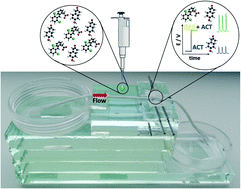Low cost microfluidic device based on cotton threads for electroanalytical application†
Abstract
Microfluidic devices are an interesting alternative for performing analytical assays, due to the speed of analyses, reduced sample, reagent and solvent consumption and less waste generation. However, the high manufacturing costs still prevent the massive use of these devices worldwide. Here, we present the construction of a low cost microfluidic thread-based electroanalytical device (μTED), employing extremely cheap materials and a manufacturing process free of equipment. The microfluidic channels were built with cotton threads and the estimated cost per device was only $0.39. The flow of solutions (1.12 μL s−1) is generated spontaneously due to the capillary forces, eliminating the use of any pumping system. To demonstrate the analytical performance of the μTED, a simultaneous determination of acetaminophen (ACT) and diclofenac (DCF) was performed by multiple pulse amperometry (MPA). A linear dynamic range (LDR) of 10 to 320 μmol L−1 for both species, a limit of detection (LOD) and a limit of quantitation (LOQ) of 1.4 and 4.7 μmol L−1 and 2.5 and 8.3 μmol L−1 for ACT and DCF, respectively, as well as an analytical frequency of 45 injections per hour were reached. Thus, the proposed device has shown potential to extend the use of microfluidic analytical devices, due to its simplicity, low cost and good analytical performance.


 Please wait while we load your content...
Please wait while we load your content...